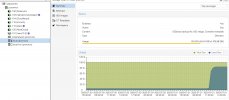I'm fairly new to proxmox.
On my home lab (intel nuc, single 2TB SSD drive) I installed proxmox 8 and in it.
My goal is to run:
- A Samba server to act as a home NAS (I know a single drive NAS is not the safest, but I could perform regular backups to amazon S3)
- A photo library manager (Immich)
- Home Assistant
- Plex
- Maybe NextCloud
- Other minor stuff.
I did manage to do all that but each container has its own space disk. Ideally I'd like to have volume or folder that is shared with all containers (at least the ones that need mass storage, like plex and Immich) and that also be mounted and shared in the samba container.
What's the best way to achieve this?
I though that I could assign almost all the available space to the samba container and try to mount that NFS storage in all containers, but I couldn't make it work on unprivileged containers.
I then discovered that you can create a folder in the host volume and mount it as what's called bindmounts in as many containers as I want (if they are privileged at least), but when I create proxmox I didn't anticipate this and I've assigned only 100G to the host and I don't see a way to resize that.
I feel that this shouldn't be so complicated and I'm missing something. How would you mount shared storage in many different containers?
On my home lab (intel nuc, single 2TB SSD drive) I installed proxmox 8 and in it.
My goal is to run:
- A Samba server to act as a home NAS (I know a single drive NAS is not the safest, but I could perform regular backups to amazon S3)
- A photo library manager (Immich)
- Home Assistant
- Plex
- Maybe NextCloud
- Other minor stuff.
I did manage to do all that but each container has its own space disk. Ideally I'd like to have volume or folder that is shared with all containers (at least the ones that need mass storage, like plex and Immich) and that also be mounted and shared in the samba container.
What's the best way to achieve this?
I though that I could assign almost all the available space to the samba container and try to mount that NFS storage in all containers, but I couldn't make it work on unprivileged containers.
I then discovered that you can create a folder in the host volume and mount it as what's called bindmounts in as many containers as I want (if they are privileged at least), but when I create proxmox I didn't anticipate this and I've assigned only 100G to the host and I don't see a way to resize that.
I feel that this shouldn't be so complicated and I'm missing something. How would you mount shared storage in many different containers?





